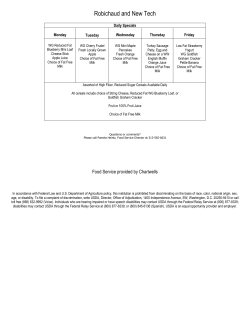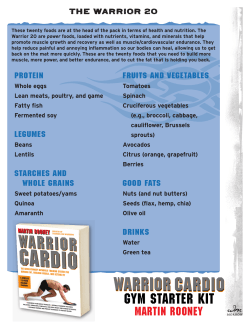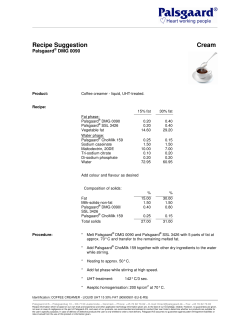
Diabetes Meal Planning for the Chinese American Client
Diabetes Meal Planning for the Chinese American Client Vegetables Fruit Milk/Other Calcium-Rich Foods Grains, Beans, Starchy Vegetables Meat / Other Protein-Rich Foods Funded by a grant from the Centers for Disease Control and Prevention. 7/12. GRAINS, BEANS, STARCHY VEGETABLES •Choose whole-grain foods such as whole-grain bread or crackers, bran cereal or brown rice. •Use whole-wheat or other whole-grain flours in cooking and baking. •Choose beans as a good source of fiber. •Choose more low-fat breads, such as rolls and English muffins. •Choose low-fat crackers for snacks. •Limit use of packaged instant noodles such as ramen, as most of them are high in fat as well as sodium. •Be sure to spread your servings of starches throughout the day. FRUIT •Choose whole fruits often. They have more fiber than juices. •Choose fruit and fruit juices without added sweeteners or syrups. •Try to choose vitamin C rich foods such as oranges, tangerines, grapefruit, and pumelo. VEGETABLES •Choose fresh or frozen vegetables without added sauces, fats, or salt. • Limit use of preserved vegetables. •Choose more dark-green and deep-yellow vegetables, such as spinach, broccoli, carrots, chilies, peppers, bok choy, choy sum, bitter melon, and Chinese mustard greens. MEAT / PROTEIN-RICH FOODS •Choose fish and poultry more often, and remove the skin. • Select lean cuts of beef, lamb, or pork. • Trim all visible fat from meat. • Skim fat from soups. • Steam, stir-fry with limited oil, or boil instead of deep-fat frying. • Limit use of oil. Add artificial sweeteners to unsweetened soybean milk if you prefer a sweet taste. •Canned sardines packed in water and dried fish are good sources of calcium. •Tofu made with calcium sulfate is a good source of calcium. •Many Chinese greens (bok choy, Chinese broccoli, kale) are good sources of calcium. •Sweetened soybean milk has added sugar and more calories. MILK / CALCIUM-RICH FOODS meal. Check with your health care professional about a safe amount for you. •If you choose to drink alcohol, limit the amount and have it with a ALCOHOL SWEETS •Eat sweets less often because they are high in sugar and often fat, too. •When you eat sweets, substitute them for starches or fruits. Don’t eat them as extras. •Limit use of sweetened condensed milk. FATS •Eat less saturated fat. Saturated fat is usually solid at room temperature. It is mostly found in meat and animal products, such as hamburger, bacon, butter, Chinese sausage, organ meats, chicken, and pork fat. •Coconut milk is also high in saturated fat. •Replace chicken or pork fat in cooking with oils such as canola, olive and peanut. •Choose products without palm oil or coconut oil. portion sizes. •If you are trying to lose weight, cut down on your •Try not to skip meals. • Eat about the same amount of food everyday. •Eat meals and snacks at regular times everyday. Tips for Healthy Meal Planning
© Copyright 2025





















